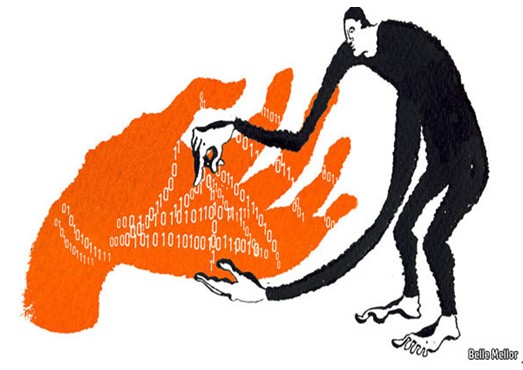
『商家通过对微博、博客、Facebook等网上留言进行自然语言分析,从而窥探出顾客的情绪、意图等,据此作出市场预测。』
Can Twitter predict the future?
微博能预测未来吗?
Jun 2nd 2011 | from The Economist

ONE day in 2008 an anonymous Twitter user posted a message: “I am certainly not bored. way busy! feel great!” That is all well and good, one might think, but utterly uninteresting to anyone besides the author and, perhaps, a few friends. Not so, according to Johan Bollen, of Indiana University Bloomington, who collected the tweet, along with plenty of others sent that day. All were rated for emotional content. Many proved similarly chirpy, scoring high on confidence, energy and happiness. Indeed, Dr Bollen reckons, on the day the tweet was posted, America’s collective mood perked up a notch. When he and his team examined all the data for the autumn and winter of 2008, they found that Twitter users’ collective mood swings coincided with national events. Happiness shot up around Thanksgiving, for example.
The idea of tapping web-based data to build a real-time measure of users’ emotions and preferences is not new. Nor is that of using the results to predict their behaviour. Interest in internet forecasting was sparked by a paper published in 2009 by Hal Varian, Google’s chief economist. He found that the peaks and troughs in the volume of Google searches for certain products, such as cars and holidays, preceded fluctuations in sales of those products. Other researchers have shown that searches for job-related terms are a good predictor of unemployment rates and that mentions of political candidates on Twitter correlate with electoral outcomes.
All such initiatives face a problem, though. Humans excel at extracting meaning and sentiment from even the tiniest snippets of text, a task that stumps machines. To a computer, a tweet that reads “Feeling joyful after my trip to the dentist. Yeah, really” says that the author has been to the dentist and is now happy. Researchers have recently made strides in teaching machines to recognise such sarcasm, as well as double meanings or cultural references. In February Watson, a supercomputer devised by IBM, trounced two human champions at “Jeopardy!”, an American quiz show renowned for the way its clues are laden with ambiguity, irony, riddles and puns. But, for the most part, processing natural language remains a challenge.
Then there is the question of how the new methods compare with existing approaches. Duncan Watts, an internet researcher who heads one of Yahoo!’s research labs in New York, likes to cite the example of weather forecasting in Santa Fe, New Mexico. A forecast that predicts sunshine every day would be correct 80% of the time, he quips. It would also be worthless, since locals already know that the town gets over 300 days of sun every year. In other words, to be useful a forecasting technique must add something to what is already known.
Dr Watts looked at areas, like films’ box-office receipts, music and video-game sales, where some public data are available. How a film does at the box office, for instance, can be predicted based on bits of previously aggregated data: its production budget, the number of screens it opens on and wagers from HSX, a website which lets people place bets on movie revenues. Adding search data to the model, Dr Watts found, produced no improvement.
Search-related methods did, however, fare better when forecasting video-game sales, where there are only two types of publicly available information to hand: ratings from reviews and, if the game is a sequel, sales figures for its predecessor. Forecasting models which added search data into the mix were much more accurate than those that did not. The same was true of music, another area where pre-packaged information is scarce.
Dr Watts thinks that simple search-volume forecasts will help spot consumer trends of this sort with increased precision. But the improvements they bring will be incremental. Sophisticated methods based on natural-language analysis of tweets, blogs, or Facebook pages, by contrast, hold greater disruptive potential. As users of social media grow accustomed to sharing highly personal information, apparently unfazed by market-research outfits watching their every step, the feelings and intentions of hundreds of millions of people are there for data-hungry computers to see. And thanks to the likes of Dr Bollen, they are becoming increasingly legible. (688 words)
特别声明:①凡本网注明稿件来源为"原创"的,转载必须注明"稿件来源:育路网",违者将依法追究责任;
②部分稿件来源于网络,如有侵权,请联系我们沟通解决。
25人觉得有用
24
2011.10
『最新研究发现,当看到红色,人们的反应会变得更快、更有力。』 Color Red Increases the Speed a......
24
2011.10
『2011年6月5日是艾滋病病毒发现三十周年纪念日。三十年来,艾滋病研究领域取得了诸多突破性的成果,但......
24
2011.10
『由于全球经济遭受了一个又一个破坏性的冲击,美国经济的复苏阻力重重,美国劳动力市场也随之萎靡不振......
24
2011.10
『流动劳动力不仅自己受益,如学习新技术,积累储蓄等,还给接收他们的富有国家创造劳动机会,并有可能......
24
2011.10
『没有一种密码是100%安全的,然而有一种新的方法能使被偷的密码失效。』
新的方法能使被偷的密码失......
24
2011.10
『虽然谷歌互联网电视目前仍不被消费者和生产商们认可,但还需几年来判定这一产品是成功还是失败,目前......